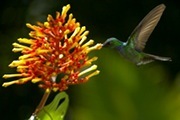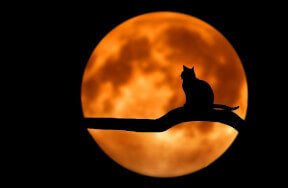It's no secret that the animal kingdom is impressive in too many ways to count. But there is just something so majestic about the vibrant plumage and distinctive bright colours on tropical birds that make them so easy to admire! Experts say that up to 900 species of tropical land birds around the world could possibly become extinct by 2100 because of global warming. Learn more about these beautiful birds and find out more about how we can help ensure the future of our planet and all of its wonderful creatures!
The Toucan
One of the most recognizable birds in the world, the toucan calls South America's tropical forests home and is known for its oversized, colorful bill that measures an impressive 7.5 inches long. They may be emblazoned on your box of Fruit Loops but the toucan is more than just a pretty bird. The bill is used as a feeding tool to reach branches to select fruit or insects and even as a mating tool by playfully passing food to each other. These easy to spot birds are around 25 inches tall tend to live in groups of six and make their nest in tree holes. Once they mate, they lay 2-4 eggs a year - but those famous bills don't reach full size for a few months. Sometimes they can be kept but we prefer to think of them nesting in a leafy tropicaltree!
 The Toucan and his famous beakCourtesy of www.sciencejournal.com
The Toucan and his famous beakCourtesy of www.sciencejournal.com
The Macaw
A member of the well-known parrot family, the Macaw boasts some super bright feathers and a distinctive personality. Their natural habitat is Central and South American rain forests with their tropical colored plumage perfectly blending with bright exotic fruits and greenery. Macaws have extremely powerful beaks that can easily crack nuts and seeds and their tongues have a special bone inside that they use to tap fruits - clever birds! Famous for being talking parrots, they range in size from 12-40 inches and are highly intelligent social birds that flock together in groups of 10-30. Most people know that some macaws (or parrots) can even mimic human speech patterns, making them a popular choice for bird lovers to have as pets. There are 17 different species of Macaw and some of them are considered endangered species. Here's hoping these beautiful birds are here to stay on planet earth.
 A group of colorful macaws relaxCourtesy of www.telegraph.co.uk
A group of colorful macaws relaxCourtesy of www.telegraph.co.uk
The Manakin
Part of the Pipridae family, these small sparrow sized tropical birds have a compact and plump shape with vivid eyes that stand out on their head. Small and cute they may look but they have a fierce personality with some odd habits. To scare their enemies, Manakins bring their wings together behind their backs and make scary noises to get them to go away. This little bird definitely has some attitude! They live in southern Mexico and northern Argentina, Paraguay and southern Brazil as well as Trinidad and Tobago. The manakin has a one-of-a-kind courting ritual that involves a dance, special wing feather actions and trills that certainly make it stand out even in a crowd of tropical birds!
 Cute and compact, the Manakin perches on a branchCourtesy of www.bbc.co.uk
Cute and compact, the Manakin perches on a branchCourtesy of www.bbc.co.uk
The Pelican
Another tropical bird with a distinctive beak, the Pelican wading on a sandy beach is a familiar scene to a lot of people. Their famous throat pouch is handy for catching fish, tipping excess water out and swallowing it immediately! An amazing fact is that the American pelican can store up to 3 gallons of water in its bill! Baby pelicans get food from their parents by simply sticking their bills into their parents' throats to retrieve the catch of the day. These large birds are much bigger than people imagine them to be and they can be as tall as 5.8 ft with a wingspan of 10 ft - nothing to sneeze at there! They can be found on the world's coastlines, lakes and rivers and travel in flocks.
 The Pelican floats on a familiar lake.Courtesy of www.nationalgeographic.co.uk
The Pelican floats on a familiar lake.Courtesy of www.nationalgeographic.co.uk
Save the Birds!
The Wildlife Conservation Society works to conserve birds and their natural habitats all around the world from Alaska to Indonesia and the tropical rainforests in Brazil. Birds are a diverse bunch and they are the first species to suffer when climate change or pollution take hold in an ecosystem. Learn more about the beautiful birds populating our planet (many of whom are endangered) and spread the word at www.wcs.org!
 Wildlife Conservation SocietyCourtesy of www.wcs.org
Wildlife Conservation SocietyCourtesy of www.wcs.org
Have your say
Which one is your favorite tropical bird? Share your comments below!

































